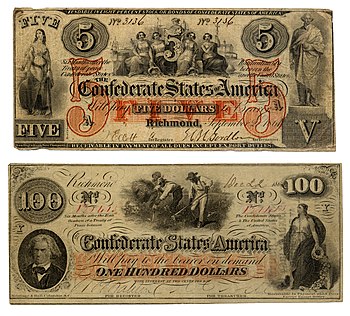 |
| Confederate Money |
Although the majority of southerners supported the war effort and
voted for secession, it was not unanimous. There was a sizable belt
of opposition centered in the Appalachian Mountains from West
Virginia down to western North Carolina. West Virginia. The
opposition during the war was fueled by the Confederacy’s financial
problems.
One problem both sides faced during the war was rampant inflation.
They turned to printing paper money to help pay for the war. However
this increased the money supply, raising prices and decreasing the
value of everyone's money. The problem was more acute in the
Confederacy. The North approximately doubled its money supply during
the war, the South increased theirs by 20 times. Inflation rapidly
increasing prices in the south, quickly doubling, tripping and
quadrupling. At the beginning of 1863 a barrel of flower could be
bought for $70, but by the end of the war it would cost $250. That
barrel of flower would have been only $10 when the war began.
 |
| Richmond Bread Riot |
Complaints from the southern people came to a crisis in Richmond
on April 2nd, 1863. There had been a drought in 1862 and much of the
food that was grown was destroyed by moving armies. Food was scarce
and very expensive. The riot began when a woman named Mary Jackson
riled up a crowd by complaining of the cost of food. Pulling out a
revolver and bowie knife, she led a crowd of 300 women with shouts of
"Bread! Bread!" The governor came out and read the Riot
Act, but the mob ignored him, smashing the windows of shops and
stealing not only food, but anything they could lay their hands on. A
company of milita was brought out, and Jefferson Davis himself came
to try to disperse the crowd. Reached into his pockets, he pulled out
all the money he had and thew it to the rioters, shouting:
You say you are hungry and have no
money. Here is all I have. It is not much, but take it. We do not
desire to injure anyone, but this lawlessness must stop. I will give
you five minutes to disperse. Otherwise you will be fired on.
The women, knowing that Davis was not making an idle threat, began
to disperse. Davis was able to quell this riot with the threat of the
soldiers rifles, but there were others elsewhere throughout the
south. Similar events occurred in Georgia, Alabama and North Carolina.
Although they turned out not serious in and of themselves, they were
signs of growing discontent with the government.
 |
| Jefferson Davis |






0 comments:
Post a Comment